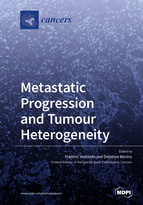Metastatic Progression and Tumour Heterogeneity
A special issue of Cancers (ISSN 2072-6694).
Deadline for manuscript submissions: closed (15 August 2019) | Viewed by 107837
Special Issue Editors
Interests: gastro-intestinal cancers; tumor progression; metastasis; treatment response; tumor heterogeneity; cell adhesion; cell signaling
Special Issue Information
Dear Colleagues,
Intratumoral heterogeneity is one of the biggest current challenges for cancer therapy. However, exciting recent developments in single-cell -omics, cellular tracking, and imaging, alongside the expansion of new tools to study clonal and phenotypic diversity in patient samples—such as PDXs, organoids, and liquid biopsies—enable a deeper understanding of the heterogeneous molecular mechanisms that drive tumor progression and underlie poor treatment outcomes.
These new research approaches have unraveled an unforeseen level of cellular and molecular complexity within tumors. High-throughput sequencing has highlighted the broad inter- and intra-tumoral heterogeneity that exists amongst patient cohorts and across tumor streams, while longitudinal studies indicate that the diversity of malignant cell populations that make up primary tumors and metastases can evolve in space and time. Cancer therapies can also reshape the cellular and molecular profile of tumors, and the elucidation of the mechanisms that drive treatment-induced plasticity, selection, and resistance will inform the design of new combinational therapies.
Furthermore, the cellular and molecular features of the tumor microenvironment, including immune cells, have to be taken into consideration for the understanding of tumor progression. Targeting both tumor cells and tumor microenvironment is also an exciting area of investigation, with new approaches such as immunotherapy now emerging as powerful treatment alternatives. Importantly, the heterogeneity of microenvironmental effectors and signals is still marginally understood and will undoubtedly represent the focus of extensive analyses in the next few years.
Thus, comprehensive and integrated analyses of tumor and microenvironment heterogeneity are essential to both improve the overall diagnosis and treatment of patients with cancer and further progress towards precision medicine. This Special Issue will highlight the state-of-the-art technologies aiming to dissect the heterogeneity of malignant cells and their microenvironment and will cover some of the promising discoveries that are likely to improve cancer patients’ outcome.
Assoc. Prof. Fred Hollande
Dr. Delphine Merino
Guest Editors
Manuscript Submission Information
Manuscripts should be submitted online at www.mdpi.com by registering and logging in to this website. Once you are registered, click here to go to the submission form. Manuscripts can be submitted until the deadline. All submissions that pass pre-check are peer-reviewed. Accepted papers will be published continuously in the journal (as soon as accepted) and will be listed together on the special issue website. Research articles, review articles as well as short communications are invited. For planned papers, a title and short abstract (about 100 words) can be sent to the Editorial Office for announcement on this website.
Submitted manuscripts should not have been published previously, nor be under consideration for publication elsewhere (except conference proceedings papers). All manuscripts are thoroughly refereed through a single-blind peer-review process. A guide for authors and other relevant information for submission of manuscripts is available on the Instructions for Authors page. Cancers is an international peer-reviewed open access semimonthly journal published by MDPI.
Please visit the Instructions for Authors page before submitting a manuscript. The Article Processing Charge (APC) for publication in this open access journal is 2900 CHF (Swiss Francs). Submitted papers should be well formatted and use good English. Authors may use MDPI's English editing service prior to publication or during author revisions.
Keywords
- Tumor Progression
- Heterogeneity
- Cancer Therapy
- Biopsies
- Microenvironment








